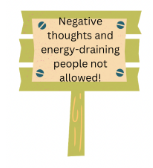A Gatekeeper for Your Mind
How to Teach Kids to Limit their Negative Thoughts
When you think of a gatekeeper, what images come up? For me, it is a person standing in front a a gate at the zoo, for some reason. You may think of the King's Guard at Buckingham Palace with their tall black hats and red uniforms.
Whatever your image is, the concept of the gatekeeper is the same. It is someone employed to limit access to somewhere or something.
The concept of the gatekeeper can be used to teach our children how to protect themselves from unwanted thoughts, people, or situations.
In life, we don’t necessarily get what we want, we get what we allow into our life.
We need to teach children that they get to decide what they let into their life. It is up to them to set the standards for their world.
The gatekeeper establishes a boundary for their life and their mind. It is their job to determine what are the limits of this boundary, who and what is let in, and who and what is not.
The concept of a gatekeeper may help them feel safe. Knowing that there is someone or something at the gate is a comforting thought, even if it's a construct of their mind.
The Gatekeeper for Their Mind
Mind Management is essential for all children (and adults for that matter). We must manage our mind and the best way to teach kids to do that is by having them employ a gatekeeper to keep out the unwanted thoughts.
Without a gatekeeper, every thought is allowed into your brain - the good, the bad, the true, and the false.
Would you let just anyone into your house? No, that is why you have a door and a doorbell. When someone comes to your door, you decide whether you want to let them into your house or not.
You can and should do the same thing for your mind. Don't let just any thoughts inside.
Instead, be thoughtful with your choice. Only allow the good and/or productive thoughts inside.
Sometimes you need to let in an unpleasant thought because you need to do some work around it. You need to figure out where the thought came from and work through it so it doesn’t come knocking at your door again. Once you do that, you learn about yourself, you grow, you level up.
But some thoughts are just straight-up unproductive and useless, such as, “I am worthless,” “I can’t do anything right” or “Things never work out for me. “ These are the thoughts your gatekeeper will make sure do not get through.
So, how can we teach our kids not to let these unproductive negative thoughts enter their minds? Start by explaining the concept of the gatekeeper. Having a visual of the gatekeeper will help kids understand this concept, as it is something they are familiar with. They can even make a name for their personal gatekeeper (e.g., Gary the Gatekeeper).
Next, explain that they should train their gatekeeper to ask questions when a certain thought approaches the gate (their mind). For instance, “Is this true?” If not, entrance denied. Next, “Is this useful?” If not, entrance denied.
You can assist them with training their gatekeeper by noticing when they express a negative thought. You can say something like, “Oh, I guess Gary let that one by, huh?” or “Gary is not doing his job today, is he? That thought should not be allowed in.” This will help them recognize the negative thought and train their gatekeeper not to allow it.
Another part of training their gatekeeper is teaching them about replacement thoughts. Not only should their gatekeeper not let in negative thoughts, but they should also offer a new thought in their place. For example, if you hear your child say, “I will never figure this out,” that can be replaced with, “How can I figure this out?”
You can explain that part of their gatekeeper’s job is to come up with replacement thoughts. So, when you hear them voice a negative thought (e.g., “I am bad at math”), you can tell them to train their gatekeeper and come up with some replacement thoughts such as “I am learning math” or “I am working on getting better at math every day.”
Being in control of your thoughts also allows you to retain control over your emotions and, thus, your actions. An untrained mind can be a source of stress and anxiety for children as well as adults.
The Gatekeeper for Their Physical World
Just as your child employs a gatekeeper for their mind, they can apply this concept to their physical world. By this, I mean that they should create boundaries and standards for their life so that they don’t let in people or things that will cause them harm.
Now I know that we cannot swathe our kids in bubble wrap to make sure nothing bad happens to them. Bad things will happen to them throughout their life no doubt.
But what we can do is teach them tools to deal with negative people or things that may try to enter their life.
For instance, if someone is being mean or overly aggressive, they may decide this person does not belong in their life, and their gatekeeper is going to keep them out. It is the idea that they have a gatekeeper that will help them make the decision to say, “I am not going to tolerate this.”
The purpose of the gatekeeper is to say, “This is what’s allowed in my world,” and then give people free will to decide if they want to abide by your rules so that they can get beyond the gate.
You are not trying to control other people; you are just creating a boundary as to what is allowed in your world. It is the other person’s decision whether to change their behavior.
The gatekeeper allows you to set limits and expectations for your world.
Teaching your child to employ a gatekeeper for their mind as well as their physical world will help them navigate life in a positive and productive way. It will teach them that they are in control. They have the power to decide what they let into their life.
The gatekeeper allows you to live your life on your terms.
Challenge: Discuss the concept of the gatekeeper with your child and come up with thoughts (and other things) that they do not want to allow into their world. Then have your child give these instructions to their gatekeeper.
If you enjoyed this post, please sign up to receive our monthly blog, where we will continue the discussion of teaching kids the power of their minds.





